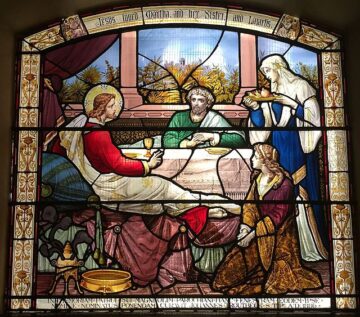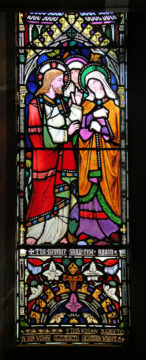Franciscan Friar Fr. Paul Gallagher reflects on the Gospel of the Fifth Sunday of Lent. John tells us in this gospel that when Jesus encountered the sorrow of Martha and Mary and the reality of the tomb, Jesus wept. What is John telling us about Jesus, and about God?
The content is edited by Franciscan Sister of Christian Charity Sister Anne Marie Lom and Joe Thiel. The excerpts from the Sunday readings are prepared by Joe Thiel. To read or download the complete pdf with excerpts for your prayer, please click here Franciscan Gospel Reflection March 26 2023. Excerpts are from the Lectionary for Mass for Use in the Dioceses of the United States of America, second typical edition © 2001, 1998, 1997, 1986, 1970 Confraternity of Christian Doctrine, Inc., Washington, DC. Used with permission. All rights reserved. No portion of this text may be reproduced by any means without permission in writing from the copyright owner. Photos: Amandajm, CC BY-SA 3.0 <https://creativecommons.org/licenses/by-sa/3.0>, via Wikimedia Commons; Andrewrabbott, CC BY-SA 4.0 <https://creativecommons.org/licenses/by-sa/4.0>, via Wikimedia Commons.
John 11:1-45 (The text in italics is omitted in the short form.)
 Now a man was ill, Lazarus from Bethany, the village of Mary and her sister Martha. Mary was the one who had anointed the Lord with perfumed oil and dried his feet with her hair; it was her brother Lazarus who was ill. So the sisters sent word to him, saying, “Master, the one you love is ill.” When Jesus heard this he said, “This illness is not to end in death, but is for the glory of God, that the Son of God may be glorified through it.”
Now a man was ill, Lazarus from Bethany, the village of Mary and her sister Martha. Mary was the one who had anointed the Lord with perfumed oil and dried his feet with her hair; it was her brother Lazarus who was ill. So the sisters sent word to him, saying, “Master, the one you love is ill.” When Jesus heard this he said, “This illness is not to end in death, but is for the glory of God, that the Son of God may be glorified through it.”
Now Jesus loved Martha and her sister and Lazarus. So when he heard that he was ill, he remained for two days in the place where he was. Then after this he said to his disciples, “Let us go back to Judea.” The disciples said to him, “Rabbi, the Jews were just trying to stone you, and you want to go back there?” Jesus answered, “Are there not twelve hours in a day? If one walks during the day, he does not stumble, because he sees the light of this world. But if one walks at night, he stumbles, because the light is not in him.” He said this, and then told them, “Our friend Lazarus is asleep, but I am going to awaken him.” So the disciples said to him, “Master, if he is asleep, he will be saved.” But Jesus was talking about his death, while they thought that he meant ordinary sleep. So then Jesus said to them clearly, “Lazarus has died. And I am glad for you that I was not there, that you may believe. Let us go to him.” So Thomas, called Didymus, said to his fellow disciples, “Let us also go to die with him.”
When Jesus arrived, he found that Lazarus had already been in the tomb for four days. Now Bethany was near Jerusalem, only about two miles away. And many of the Jews had come to Martha and Mary to comfort them about their brother. When Martha heard that Jesus was coming, she went to meet him; but Mary sat at home. Martha said to Jesus, “Lord, if you had been here, my brother would not have died.
But even now I know that whatever you ask of God, God will give you.” Jesus said to her, “Your brother will rise.” Martha said to him, “I know he will rise, in the resurrection on the last day.” Jesus told her, “I am the resurrection and the life; whoever believes in me, even if he dies, will live, and everyone who lives and believes in me will never die. Do you believe this?” She said to him, “Yes, Lord. I have come to believe that you are the Messiah, the Son of God, the one who is coming into the world.”
When she had said this, she went and called her sister Mary secretly, saying, “The teacher is here and is asking for you.” As soon as she heard this, she rose quickly and went to him. For Jesus had not yet come into the village, but was still where Martha had met him. So when the Jews who were with her in the house comforting her saw Mary get up quickly and go out, they followed her, presuming that she was going to the tomb to weep there. When Mary came to where Jesus was and saw him, she fell at his feet and said to him, “Lord, if you had been here, my brother would not have died.” When Jesus saw her weeping and the Jews who had come with her weeping, he became perturbed and deeply troubled, and said, “Where have you laid him?” They said to him, “Sir, come and see.” And Jesus wept. So the Jews said, “See how he loved him.” But some of them said, “Could not the one who opened the eyes of the blind man have done something so that this man would not have died?”
So Jesus, perturbed again, came to the tomb. It was a cave, and a stone lay across it. Jesus said, “Take away the stone.” Martha, the dead man’s sister, said to him, “Lord, by now there will be a stench; he has been dead for four days.” Jesus said to her, “Did I not tell you that if you believe you will see the glory of God?” So they took away the stone. And Jesus raised his eyes and said, “Father, I thank you for hearing me. I know that you always hear me; but because of the crowd here I have said this, that they may believe that you sent me.” And when he had said this, he cried out in a loud voice, “Lazarus, come out!” The dead man came out, tied hand and foot with burial bands, and his face was wrapped in a cloth. So Jesus said to them, “Untie him and let him go.” Now many of the Jews who had come to Mary and seen what he had done began to believe in him.
Background:
 This text is one of the most important texts for the Christian community and it is one of longest. Only the passion accounts are longer.
This text is one of the most important texts for the Christian community and it is one of longest. Only the passion accounts are longer.
The gospels contain three accounts of Jesus restoring life to the dead. Both Mark and Luke describe the healing of Jairus’ daughter (Mark 5:22-24, 35-43 and Luke 8:41-42, 49-56). Jairus comes to Jesus while his daughter is still sick and asks Jesus to come and heal her. While they are speaking, they receive news of the death of the young girl. Jesus goes with Jairus to his daughter’s side and restores her to life. The second account of Jesus raising someone to life is only recorded in Luke’s gospel. (7:12-17). A widow is leaving the town of Naim to bury her only son who had died sometime earlier that day. Jesus encounters the woman as he is entering the city and is moved by the situation. He stops the burial procession and restores the man to life. Luke does not say how long the man had been dead, but it was longer than Jairus’ daughter. In today’s text, Lazarus has been dead four days. Rabbinical belief was that the spirit stayed close to the body for three days before departing. John is making sure that the raising of Lazarus is unlike anything that Jesus has done previously.
Lazarus was a close personal friend whom Jesus loved. Throughout the passage there are comments about Jesus’ relationship with Lazarus, Mary, and Martha. John tells us that Jesus wept at the tomb of his friend. John also makes sure that we know that Lazarus is really dead. There is not room here to support that Jesus merely healed someone who appeared to be dead.
The religious leaders’ response is also dramatic. In John’s gospel it is not the overturning of the tables in the temple that convince them that Jesus is a threat to their stability, but the raising of Lazarus. The seven verses following the gospel text are:
“But some of them went to the Pharisees and told them what Jesus had done. So the chief priests and the Pharisees convened the Sanhedrin and said, ‘What are we going to do? This man is performing many signs. If we leave him alone, all will believe in him and the Romans will come and take away both our land and our nation.’ But one of them, Caiaphas, who was high priest that year, said to them, ‘You know nothing, nor do you consider that it is better for you that one man should die instead of the people, so that the whole nation may not perish.’ He did not say this on his own, but since he was high priest for that year, he prophesied that Jesus was going to die for the nation, and not only for the nation, but also to gather into one the dispersed children of God. So from that day on they planned to kill him.” (John 11:46-53)
Why does John include this passage in his gospel? John’s gospel was the last one written. The Christian community was struggling to understand their faith in Jesus and the meaning of the resurrection. But Jesus had not returned to establish the reign of God, and many of their number had died. Had Jesus deliberately delayed his return? If so, why? Like them, both Martha and Mary believed that if Jesus had been there, he would have had the power to do something to prevent Lazarus’ death (11:21 & 11:32). Jesus’ delayed arrival does not mean he has a lack of compassion or presence.
Reflection Questions:
- Have you ever been disappointed by what feels like a lack of God’s presence?
- What do you do with that disappointment?
- What kind of relationship do you think Lazarus, Martha, and Mary really had with Jesus during his life?
- Given that relationship, how do you understand his delay in coming to them as soon as he received word that Lazarus was ill?
- When Jesus did go to be with Martha and Mary, Martha went out to meet him and Mary stayed in the house. Which of the two responses would have been more natural for you, if Lazarus was your brother?
- Have you ever felt like Martha and Mary; that if God wanted to, God could have prevented the death of someone you loved?
- John tells us in this gospel that when Jesus encountered the sorrow of Martha and Mary and the reality of the tomb, Jesus wept. What is John telling us about Jesus, and about God?
- Can you take to some time to talk to God openly and honestly about your feelings and questions that arise within you from this text, the death of people you know personally, or some other thoughts or feelings that arise in you from this gospel?


